

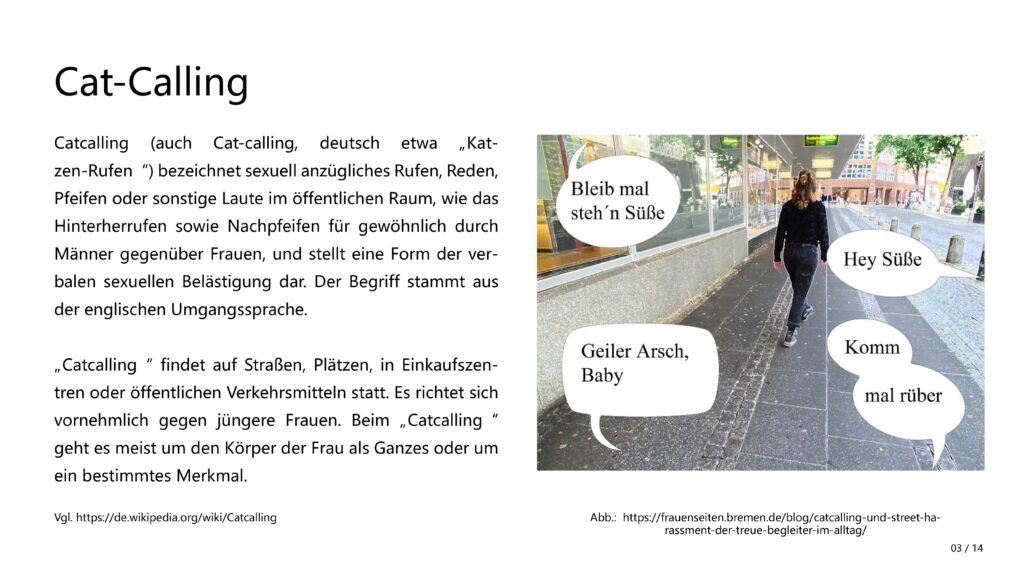

























“Even when you are made uncomfortable by a situation, you can still find it hard to get out of it. We learn from how hard it can be to do what you need to do to protect yourself. Who you are taught to be, how you are taught to be, polite, considerate, not troublesome, as a girl, as a student, is how you become more vulnerable, less willing or able to stop someone from pushing the line you need to protect yourself. When you know that to say no is to be judged as antisocial, it is hard to say no.”
(Ahmed, 2021, pg. 183)
“HELLO, I AM HERE: An Identity Crisis on Paper” is my ongoing art project, in which I am processing and establishing my place in the world. The title comes from my professor: during a meeting, in which we were discussing my work, he noted that I had been trying to make my art “illustrative” and putting too much focus on creating pieces that were aesthetically pleasing. In trying to make beautiful artwork, I was not making anything that was true to who I was as a person. He told me to try drawing and writing without putting too much forethought into it, to make my mark, to say, “Hello, I am here!”
Naturally, this challenge sent me into a tailspin. Where was I supposed to begin? How could I even start to project my inner self onto the world around me? What did I want the world to know about me, and what would that look like?
So far, I still don’t really know, but the imagery that keeps emerging is painting a picture (if you’ll pardon the expression) of the parts of myself I have trouble reconciling with.
When I was 22, a therapist noticed that I struggled to maintain eye contact with her while I spoke about the challenges of working as a waitress, and how I was embarrassed about struggling to complete basic tasks in a stressful work environment. After a quick screening test, she referred me to another, outside organisation in order to test for autism.
It has been nearly three years since this referral (thanks to a hefty waiting list), and nearly every day since has been spent picking up the pieces of this bombshell. Finally, I felt as though I understood myself on a much deeper level. It became easier to forgive myself for the explosions of anger over tiny inconveniences (God help the poor soul who would change my plans at the last moment), for my thin skin and for the routines and rituals that were once thought of as “childish”. It didn’t matter that I was not formally diagnosed (nor that I am still waiting to this day): this was the key to letting myself heal from years of confusion and self-hatred.
With this monumental relief, however, came an entirely new set of challenges. A discerning lack of validation, for one. It became remarkably easy for those around me to dismiss my newfound diagnosis, primarily on the basis that I “didn’t seem autistic”. Many times I heard the old adage, “Everyone is on the spectrum!”, always from well-meaning people, probably unsure of how to respond to such a bombastic statement as “I have autism”.
Upon further reflection, I can see how such a statement could be seen as a complaint. This quote from the book “COMPLAINT!” by Sara Ahmed resonated with me:
“Correction is often heard as complaint: as being negative, assertive, demanding. Coming out can involve an intentional disclosure, but that’s not always how coming out happens. Sometimes you have to admit something to yourself before you can admit something to others…”
(Ahmed, 2021, pg.119)
This project is my concentrated effort to be assertive, to gently remind my friends and loved ones to handle me with care.
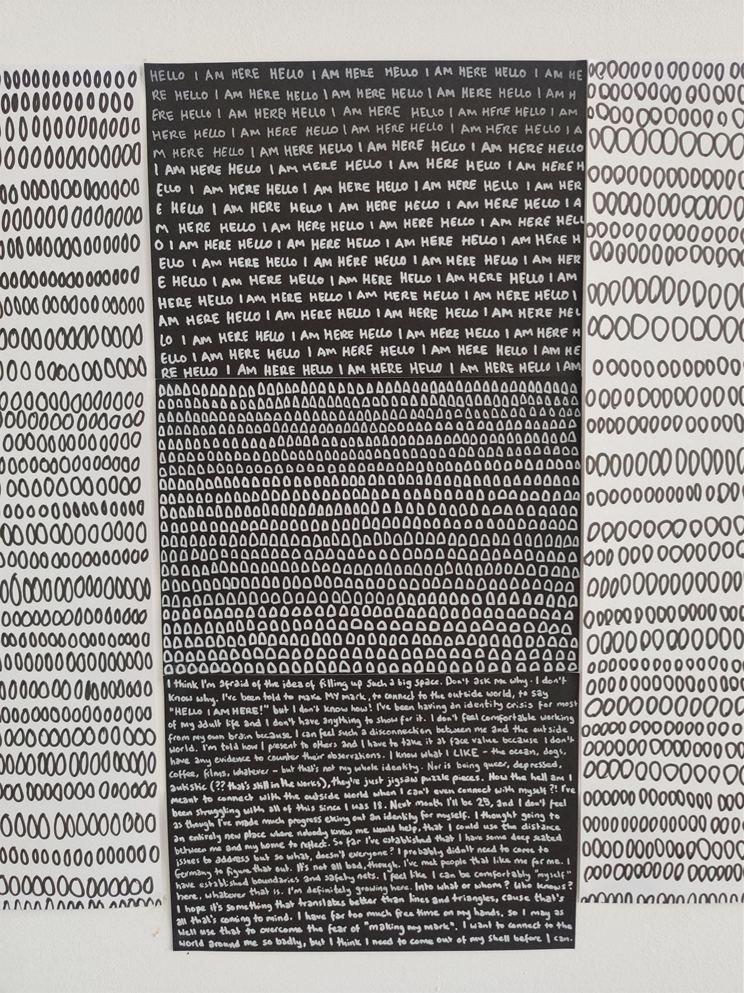

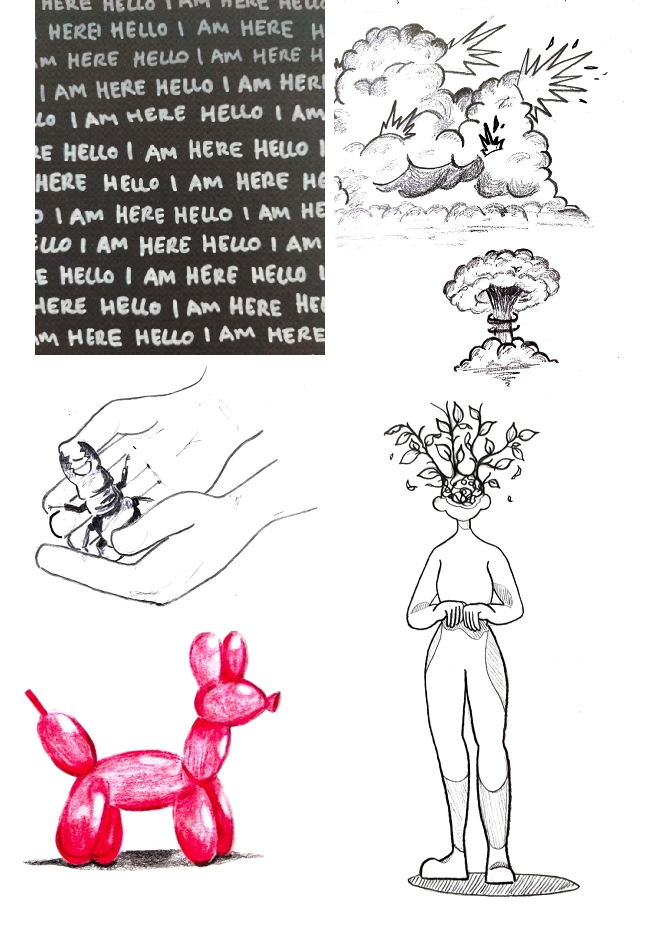

The doors in my life are two-fold.
For every revolving door, every sliding door, the doors to my studio, my flat, my new way of life,
a closet door.
If this door could talk
it would probably scream.
A piercing, blazing wail of fear,
the unknown scorching the handle.
The varnished oak gouged in scratch marks,
peeled off stickers.
I have opened this door countless times.
Slowly, haltingly, wincing at the groaning hinges.
Now and then the coast is clear,
and I fling the door open,
delighting in the slam against the wall.
The door was forced open once.
A resounding truth,
a lesson I have had to learn and teach myself,
is that there is never just one closet.
There is never just one set of doors.
I will find myself behind that door again.

“The word complaint shares the same root as the word plague, ’to strike, to lament by beating the breast.’”
(Ahmed 2021, p. 18)
As a woman, complaining is not something that comes easily. From birth, we are conditioned to view womanhood in a very restricted way, and this extends to our attitude towards complaining. A woman is supposed to be sweet and demure, effortlessly beautiful, and clean, passive, and
dependent on our male counterparts! The reality of womanhood is much uglier, much grittier. There is much to be angry about once our shared history is fully excavated. A young woman’s feminist awakening is often horrific, and her protests often fall on deaf ears.
What’s the point in having the right to vote when our voices just bounce back off the wall?
I am from Northern Ireland, a country notorious for letting down its women. In my lifetime, I have seen the decriminalisation of abortion versus the reality of not actually providing safe, accessible
healthcare. I have seen women prosecuted for a miscarriage, for procuring abortion pills for her underage daughter. I have seen a high-profile rape case against two rugby players thrown out, and with no negative effect on their careers – I still think of that poor girl, her bloodstained underwear
passed around the court. I have heard stories of “mother and baby homes” where vulnerable and
isolated young mothers as young as 12 were forced to work, their babies ripped from their arms minutes after birth (we should not have to know the phrase “12-year-old mother”).
At the time of writing this, another young woman from Ireland has been murdered in broad daylight. She was out for a run at four in the afternoon. She “did everything right” – a sentiment that erases the actions of the man who killed her.
Women should not have to conform to a set of rules to be
granted the basic human right of existing without fear. The narrative that surrounds cases such as these hints at these “rules“ each time, focusing on where the victim was, what she was doing, whether or not she was by herself, without turning to stare at the elephant in the room: the story of
violence against women at the hands of men is centuries old. It shows no signs of stopping. Society refuses to attack the problem at its root, instead looking back and asking, “What could she have done differently?” The rules we have had laid out for us do not apply. We could „do everything right“, we could take every precaution to make our lives as risk-free as possible, and there is still every chance that we could die despite it all.
My point: we have been complaining for years. We can do nothing BUT complain. There are so many human rights that we have been denied, and the white Christian majority that run our country just smile and nod. How could one NOT complain when so much is so fundamentally wrong? How do so many of these issues end up being framed as being OUR fault? We are told not to get pregnant, not to find ourselves alone, not to get too drunk, not to get spiked, not to get raped. It’s rotten and condescending.
The foundations of Northern Ireland are rotten, and its women are falling through the forming cracks.
As I read Sara Ahmed’s article, the first thought that came to mind was from a poem.
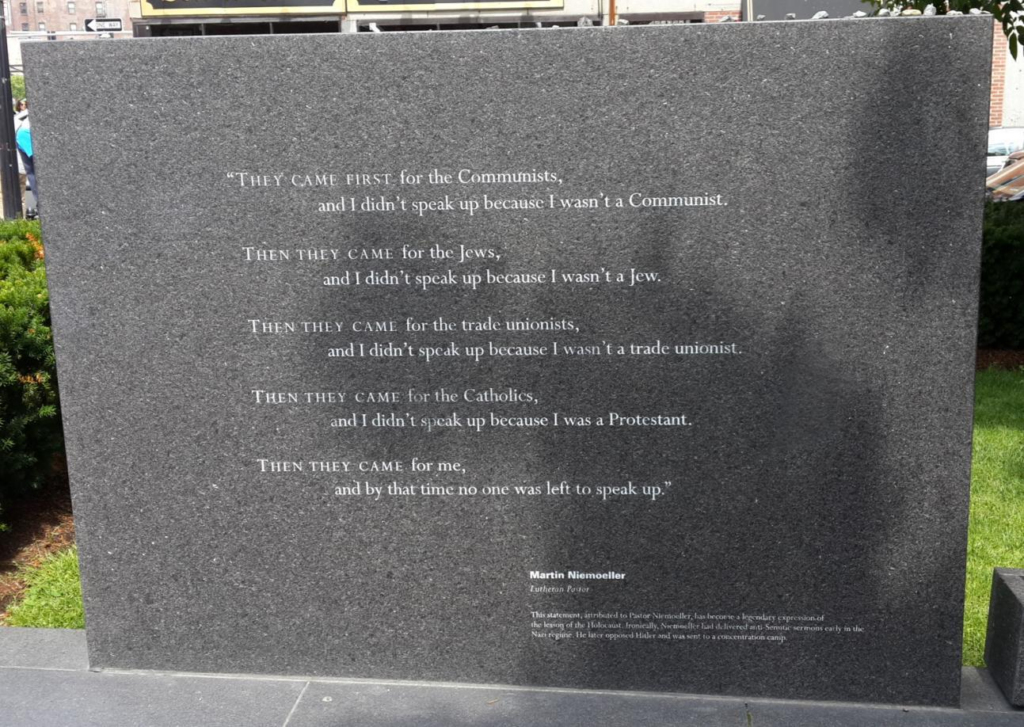
It has been translated into several languages, of which the Chinese version I read is:
“起初他们追杀共产主义者,
我不是共产主义者,我不说话.
接着他们追杀犹太人,
我不是犹太人,我不说话.
此后他们追杀工会成员,
我不是工会成员,我继续不说话.
再后来他们追杀天主教徒,
我不是天主教徒,我还是不说话.
最后,他们奔我而来,
那时再也没有人站出来为我说话.
——马丁·尼莫拉牧师 1945 年 ” [1]
The original text is:
“ They came first for the Communists,
and I didn’t speak up because I wasn’t a Communist.
Then they came for the Jews,
and I didn’t speak up because I wasn’t a Jew.
Then they came for the trade unionists,
and I didn’t speak up because I wasn’t a trade unionist.
Then they came for the Catholics,
and I didn’t speak up because I was a Protestant.
Then they came for me –
and by that time no one was left to speak up.
——Pastor Martin Niemöller 1945 ” [2]
This poem was written by the poet in his later years during his confession, when he simply wanted to speak out about his wrongdoings back then. But later generations carved it on the inscription not only because of the wrongdoings but because of the poem’s profound meaning.
In the chapter “on being stop” of Sara Ahmed’s book there is a story: A junior female scholar of color was warned by a senior professor: “You are a young scholar, and if you do this now, you will be known as a complainer, so let it go.” She was advised to “let go” so as not to be known as a “grouchy person” or “someone with a grievance”. This is because people in academia believe that not complaining is a virtue, and that those who offend this virtue will be forever ostracized from the circle. Academic circles do not tolerate complainers, so many scholars have no choice but to hold their tongue when they suffer injustice. This example shows us that the pressure of public opinion and circumstances can cause complainers to eventually choose silence. Sara Ahmed elaborates on this point in her book, and it is the reason for so many wrongdoings by Pastor Martin Niemöller, moreover, the meaning behind this poem.
This poem seems to me that it sums up very profoundly the dialectical relationship between the individual and the collective in society. And demonstrates a common phenomenon: Many of us dodge and dodge, choosing to be silent or to be silenced when making choices. By choosing to step back, we appear to have made a choice, but in fact, we cede the right to choose.We must choose to stand forward. Only then will there be truth and the things of the world will come to fruition.
On the contrary, the reasons why this is becoming more and more common can often be interpreted in the context of different national political contexts and the social state we live in. In Sara Ahmed’s article, it is also mentioned several times that complainers end up “silenced” due to various circumstances. We are in a state where the more we speak up and the more we ponder, the more silent we become. Our hearts still believe in the world, our hearts want to be a voice for ourselves and a voice for those around us. But when what we support will eventually be distorted to prove that it is immoral or unjust, our voice is like a sharp knife stabbed at the so-called righteousness and justice. Under the pressure of public opinion and the environment, will this sharpknife, which seems to be in our hands, also pierce the most vulnerable part of ourselves. I can’t help but begin to wonder this.
[1] Wikipedia contributors. “起初他們…” 维基百科, 自由的百科全书, https://zh.wikipedia.org/w/index.php?title=%E8%B5%B7%E5%88%9D%E4%BB%9 6%E5%80%91%E2%80%A6%E2%80%A6&oldid=64402682 (accessed February 20, 2021).
[2] Wikipedia contributors, “First they came …” Wikipedia, The Free Encyclopedia, https://en.wikipedia.org/w/index.php?title=First_they_came_…&oldid= 1059945909 (accessed January 14, 2022).
Ill. 1: Martin Niemoeller (Life time: 14 January 1892 – 6 March 1984), “First they came…”, 1950s. This is the “First they came…” poem attributed to Martin Niemoeller at the Holocaust memorial in Boston MA, USA
Ill. 1: Copyright expired because the work was published without a copyright notice and/or without the necessary copyright registration.
| Big gratitude to all those enthusiastic people that have made complaining such a rewarding activity. T.Kalleinen & O.Kochta Kalleinen |

From the very beginning of my professional complaining career in winter 2021, I traveled with the book of S.Ahmed and my little diary through everyday situations. At first, I took advantage of the Complainitivism blog to store there everything I could not in other places. Safe-travels blogging. I embraced the chance to hang out in the cheap hostels in Cairo, my WG in Weimar, and different flats and places I inhabited since that stimulated my writings. I remember most of my life I was so loud in complaining, loving it, and hating it simultaneously. On the other hand, it was such a good tool to protect not just me, but also somebody who could be bullied due to no voice. It means transforming the voice into something useful instead of using it for something that empowers the ego. Me, the protector, the rescuer – the one that provides space, I pictured. It already happened – entering the world of displeasure through the texts, and diving into the whole new world of complaining as art practice. There was the moment when the book divider cut Sara Ahmed’s piece in half, somewhere around Occupied spaces in Part IV, and I felt precisely the task I had – to take care of the voices pragmatically instead of theoretically. To give complaints somewhere to go and open the door. The same day I decided to propose a project called Bauhaus Complaints Choir.
Something itchy decisively and loudly screams from the bodies of these young people – I thought after the first Complaintivsm live session. Emotions and openness were splashing the walls of the institution, group therapy as if nothing will exist after it. The respect for my wonderful colleagues, it is my true pleasure to share the walls with them, while pretending that the walls do not exist. How will we proceed? How to root out the issues we mentioned there and eradicate the origin of the problem? This was the basis for the cabinet I imagined creating. The place of the singing drawers, a closet full of thoughts. The words that gravitate towards the reform and aim to dissolve the complex procedures.
BCC (Bauhaus Complaints Choir) is an experimental chorus aiming to structure and coordinate the complaints within the institution. While giving a space for the voices of the students, professors, and all employees of our university, I and my colleague Margarita Garcia decided on creating the lyrics out of the complaints we receive. Making a complaint within the institution often requires reflecting on it. BCC is a cabinet for both institutionally and privately held complaints. Allof them are welcome. The music follows the dynamics of the writings, combining global, indigenous, dispossessed, classic, and experimental.
I must share a sort of disappointment regarding the response within the BCC (Bauhaus Complaints Choir) open call, that weirdly hurt me. My fragile ego was mixing the anger, protest, sadness, and actual result of the call. For weeks there was no complaint on the form. I wondered what is the problem? There must be something standing between a person who is about to voice their displeasure and me building a cabinet and waiting for it. Is there a bug in the system, a mistake in the approach?
‘’Hey Nadja, this rocks. ‘’
‘’Bravo, I hope you get a lot of complaints.’’
‘’This is such an important project! ‘’
‘’Girl, this is what this university needs.’’
…but no complaint was appearing on our form, nor being dropped in the mail. No letter, no notification, no displeasure. It might be that I have made a piece of marketing, a product, and lost its actual objective on the way. One person even texted me that she would like to participate, but she really does not have anything to complain about. Even an apology followed this statement. I was feeding the air, the social media, and idea, but not the people, I suppose. On the other hand, there was this question: Are we so overwhelmed with the individual, inner complaints that the task to complain somewhere else, outside, feels like one more errand? I do understand this. I do not blame. I am, myself, having way too many on my list.
However, some complaints made BCC’s idea fight for its existence in my head, still taking the failure as the legitimate and integral part of the process. At some point, the letters started appearing – the response came from the crowd.

Additionally:

“If you have to complain because of failed processes, you have to enter yet more failed processes.”
S.Ahmed
If I am about to create a real cabinet for the complaints, I should take care of it in the best possible way. I have to learn from the empty spaces in the form, as much from the filled ones. Moreover, it is just the beginning of BCC’s radical wardrobe, and the door has just opened.
Valituskuoro: Who sings the things?
The world of diverse voices amazes me. From the collective art performances to the theater stage happening, I was always a big devotee and admirer of this kind of noise. Except for the melody of the crow, I am in love with complaining as a sport of choice. Therefore, I started searching for enthusiasts in the same field.
In the Finnish vocabulary, there is the expression “Valituskuoro (literally ‘’Complaints Choir’’) and it is used to describe situations where a lot of people are complaining simultaneously. In my research, I found the two names that are taking this expression seriously.

Complaint
It is my true pleasure to introduce the artist duo Oliver Kochta-Kalleinen and Tellervo Kalleinen, Helsinki-based contemporary artists working with cinema, installation, performance, and events. In their practice, they attempt to merge the languages and approaches of several disciplines, such as film, performance, game design, experimental education, facilitation, social architecture, and alternative economies. They construct situations and invite people to join her for collective adventures.
Complaints choirs took place in primary schools, streets, churches, villages, and big cities… Complainers started their movement worldwide. Better said, they occupied spaces.


Another example is The Resistance Revival Chorus from New York that introduces themselves as activists exploring music and musicians exploring activism. RRC is a collective of more than 60 women and non-binary singers, who join together to breathe joy and song into the resistance and to uplift and center women’s voices. Chorus members are touring musicians, film and television actors, Broadway performers, solo recording artists, gospel singers, political activists, educators, filmmakers, artists, and more, representing a multitude of identities, professions, creative backgrounds, and activist causes. And we have now the BCC (Bauhaus Complaints Choir) that exists in specific time and space. We are students, designers, artists, filmmakers, supervisors, tutors, professors, activists, protesters, everyday people. We are the diverse voices of a particular context and we aim to voice up.
Say complaint – and there I am, building my professional complaining career.
Sincerely, informally, with the pleasure. Yours,

I would like to start my post with this sentence from “Las Tesis” which, translated in English means “And the fault wasn’t mine where I was or how I was dressed”. This was created as part of the song and choreography “Un violador en tu camino” that this collective of women perform in the public space in 2019 the context of the social awakening in Chile.
The statement reminds me on many passages of the book, when Ahmed describes the process of filing a complaint, which can involve a series of hesitations and lack of support from the people around and also, hesitation from the self, not believing in the own judgment. In Complaintivism, about a student been harassed by her Professor: “Her first reaction is to question herself rather than his behavior. She tells herself off, even; she gives herself a talking to; she tells herself to stop being paranoid,…” ( Ahmed, pg. 104).
I also definitely relate the hymn phrase with complaint situations in which the victim is charge on responsibility for the harassment, like saying that the person (woman) was provocative, or that she was in the wrong place at the wrong time. This argument resonates as so familiar. In Chile, there are raped and abused women who, when they go to report the situation to the police, are for example asked how they were dressed, in an intention to blame the victim.
There was and still is, even beyond the “Me too” movement, a certain miss-believing on the victim’s speech, especially when abuse of power it’s implied. These miss-trusting also many times delay complaint process, resulting on people´s criticism “Why did you not complain earlier or sooner” (Ahmed pg. 113). Fortunately, in recent times and thanks to social movements, the characteristic of public climate have made people feel safer regarding speaking out these situations.
The testimonies in the book actually relate in the majority of cases with abuse of power. Sexual harassment, sexual commentaries etc… mainly directed by men. The testimonies are a synecdoche of the systematical patriarchy atmosphere that we have and still experience.
Coming back to the title of the post, what I find really powerful on “Las Tesis” work is that they created a hymn and choreography to be performed as a public act, to re-position feminist demands, in a space of power, which is the street. They embrace the collective complaining voices as a chorus and communicative bodies that are choreographed altogether in different stages in the public space. The collective action acts as a voice amplifiers of those who are afraid to reclaim, but that they feel free to do, throughout this communitarian experience.
“Complaint can feel becoming a chorus, all these conversations take up time and space in your head, more and more voices, they become loud, louder still” (Ahmed pg. 111). “Las Tesis” invite a collective body to let out this grooming voices in the head letting them out as a common scream.
In the singing and dancing, the body positions itself politically in the street, which is the most dangerous place for a woman’s body, a body that is exposed and transits into daily violence. Complaining as a collective act feels less tidy, less frightening. It is an awakening of all those who felt censored or afraid to say it.
The name of the collective comes from the aim of these four women on researching theses by feminist authors and translate them into a performative format in order to reach multiple audiences. They recognize themselves in the anti-patriarchal denunciation of writers such as argentinian Rita Segato. They have also collected testimonies from woman in context of sexual abuse and raping.
The complete song “Un violador en tu camino”:
“The patriarchy is a judge, who judges us for being born, and our punishment, is the violence you don’t see. It is feminicide. Immunity for my murderer. It is disappearance. It is rape. And the fault was not mine, nor where I was, nor how I dressed. And the fault wasn’t mine where I was or how I was dressed. The rapist was you. The rapist is you. The judges. The state. The president”
This hymn functions as a declaration for direct sexual intimidation but also as a metaphor for daily harassment or, in a macro perspective, for the systematic patriarchal order in which we are immerse, specially in the Latin-American context, where discrimination, sexual abuse and feminicide rates are still violently high.
Since the first day “Las Tesis” performed “Un violador en tu camino” the song and its choreography became a worldwide phenomenon. It was fast spread in other countries, such as Mexico and Colombia. Then they decided to make the musical base available, which was also created by them, with the idea that each territory could perform it and transform it for each context. After that “Un violador en tu camino” has been also performed in more cities in Latin-America and Europe.
in the Chilean case, “the effectivity” of the performance, evidenced in the high amount of participants in each public intervention, relays in the fact that there is still an oppression feeling by memory related with the dictatorship and the experiences of violence that the state can exercise on the citizens, oppression like the one experience by Carabineros (Chilean police) in the social awakening in 2019, where there was an evident abuse of force.
Through “Las Tesis” the feminist body re-apropiates the public space and breaks-trough spaces of masculine domination, by the power of collectivity.
Collective performance video:
https://www.lasexta.com/embed/un-violador-en-tu-camino/video/7/2019/12/08/5decdacd7ed1a8900671e334?origin=https://www.lasexta.com/noticias/sociedad/un-violador-en-tu-camino_201912085decdd020cf2203004e7ea6e.html


What does it feel like inhabiting your complaint? How do you experience, as the complainer, your body becoming a testimony of the work of complaint?1 Where do you feel the process of having to prove that you are or were underlying an experience of injustice and that were you were harmed? And how does it feel to find no support and no way out of this situation? Where do you feel it in your body? How does it manifest losing their sense of clarity and no longer being able to trust your body to tell you what is right or wrong?
1 See: Ahmed, S. (2021): Complaint!. Durham: Duke University Press, p.39.
An attempt to visualize:



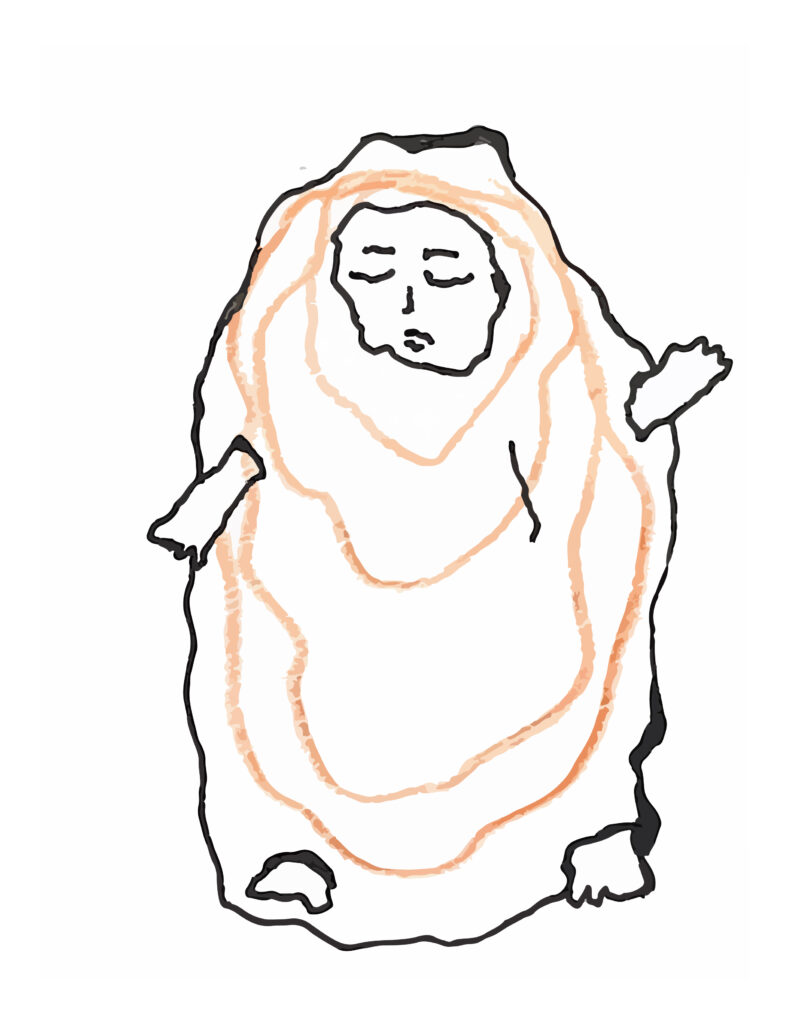





Ahmed, S. (2021): Complaint!. Durham: Duke University Press:
The less backing you have, the more weight you have to bear. (p.39)
You swallow it. (p.48)
A complaint can feel sticky: the longer it takes to make, the more it sticks to you. (p.117)
In the thick of it. (p.103)
Being shattered is not always a place from which we can speak. (p.14)
You are trying to hold yourself together. (p.117)
The lack of clarity of the process becomes the world you inhabit: nothing is clear. (p.44)
Complaints, wherever they go, often end up in filling cabinets, those handy containers. We too can become containers. (p.117)
Bodies can also store what minds file away, which is how we come to feel the truth of something in our bones. (p.108)
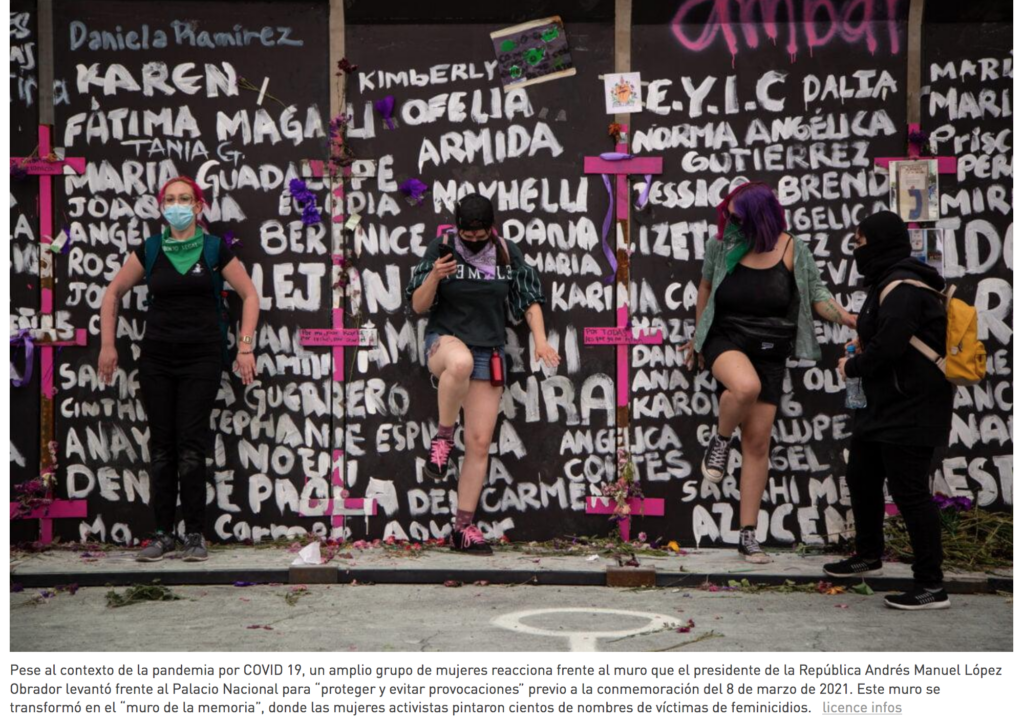
Different Feminisms in Mexico, as well as in the world, has grown enormously in recent years.
Remarkable are the ways, strategies and visual resources that have been used mainly in the latest marches/strikes/demonstrations in Mexico City. That go beyond the symbolic and affect reality.

It is unfortunate and deeply disgraceful to know that feminicides are a constant reality in Mexico, as well as domestic violence, and the difference in opportunities, just to name a few of the deep and depressing problems.
Of course, this is reflected in multiple demonstrations like the massive mobilization of March 8, 2020, which together with the strike of activities led to the massive closure of schools, emptying of streets and public transport, making the absence a political action of resistance. . Also, in September 2020, the occupation of the building of the National Human Rights Commission (CNDH) and the CODHEM in Ecatepec by activists, mothers who are victims of femicide and united groups of feminists, who have maintained this occupation, as well as the temporary occupation of several radio stations in different Mexican cities. And even more recently, in the context of the pandemic, a large group of women reacted in front of the protection wall of the government palace, turning it into “the wall of memory” where women activists painted hundreds of names of victims of femicide.

An important note is that these recent manifestations of women’s and feminist movement have demonstrated an intergenerational character that confronts an increasingly violent patriarchy, in an increasingly globalized world, with great impunity, where the continuity between public space and social networks are becoming more and more diffuse.
“Each of these characteristics are the conditions of existence of many younger women, who, although they are heirs to the long feminist tradition in Mexico, show a clear differentiation in language, action strategies and management of networks. that define their particularity, as they are part of a new generation” (Matos and Paradis, 2013).


Of course, this is not an exhaustive review of the movement, but I wanted to share in a general way the vitality with which these feminisms have taken over the streets of Mexico, literally painting almost the entire city purple and pink, graffiti on its monuments, and emitting very direct messages.
Unfortunately. Nothing is enough, as an answer to that painful reality. But it is a good start to begin to eradicate it.

V